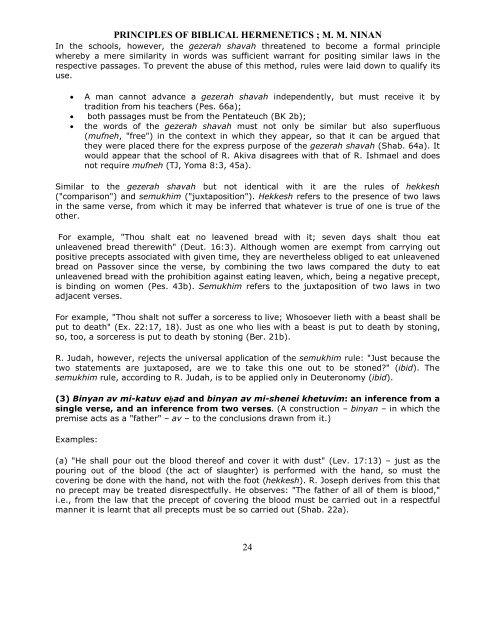Biblical Hermeneutics
You also want an ePaper? Increase the reach of your titles
YUMPU automatically turns print PDFs into web optimized ePapers that Google loves.
PRINCIPLES OF BIBLICAL HERMENETICS ; M. M. NINAN<br />
In the schools, however, the gezerah shavah threatened to become a formal principle<br />
whereby a mere similarity in words was sufficient warrant for positing similar laws in the<br />
respective passages. To prevent the abuse of this method, rules were laid down to qualify its<br />
use.<br />
• A man cannot advance a gezerah shavah independently, but must receive it by<br />
tradition from his teachers (Pes. 66a);<br />
• both passages must be from the Pentateuch (BK 2b);<br />
• the words of the gezerah shavah must not only be similar but also superfluous<br />
(mufneh, "free") in the context in which they appear, so that it can be argued that<br />
they were placed there for the express purpose of the gezerah shavah (Shab. 64a). It<br />
would appear that the school of R. Akiva disagrees with that of R. Ishmael and does<br />
not require mufneh (TJ, Yoma 8:3, 45a).<br />
Similar to the gezerah shavah but not identical with it are the rules of hekkesh<br />
("comparison") and semukhim ("juxtaposition"). Hekkesh refers to the presence of two laws<br />
in the same verse, from which it may be inferred that whatever is true of one is true of the<br />
other.<br />
For example, "Thou shalt eat no leavened bread with it; seven days shalt thou eat<br />
unleavened bread therewith" (Deut. 16:3). Although women are exempt from carrying out<br />
positive precepts associated with given time, they are nevertheless obliged to eat unleavened<br />
bread on Passover since the verse, by combining the two laws compared the duty to eat<br />
unleavened bread with the prohibition against eating leaven, which, being a negative precept,<br />
is binding on women (Pes. 43b). Semukhim refers to the juxtaposition of two laws in two<br />
adjacent verses.<br />
For example, "Thou shalt not suffer a sorceress to live; Whosoever lieth with a beast shall be<br />
put to death" (Ex. 22:17, 18). Just as one who lies with a beast is put to death by stoning,<br />
so, too, a sorceress is put to death by stoning (Ber. 21b).<br />
R. Judah, however, rejects the universal application of the semukhim rule: "Just because the<br />
two statements are juxtaposed, are we to take this one out to be stoned?" (ibid). The<br />
semukhim rule, according to R. Judah, is to be applied only in Deuteronomy (ibid).<br />
(3) Binyan av mi-katuv eḥad and binyan av mi-shenei khetuvim: an inference from a<br />
single verse, and an inference from two verses. (A construction – binyan – in which the<br />
premise acts as a "father" – av – to the conclusions drawn from it.)<br />
Examples:<br />
(a) "He shall pour out the blood thereof and cover it with dust" (Lev. 17:13) – just as the<br />
pouring out of the blood (the act of slaughter) is performed with the hand, so must the<br />
covering be done with the hand, not with the foot (hekkesh). R. Joseph derives from this that<br />
no precept may be treated disrespectfully. He observes: "The father of all of them is blood,"<br />
i.e., from the law that the precept of covering the blood must be carried out in a respectful<br />
manner it is learnt that all precepts must be so carried out (Shab. 22a).<br />
24


















